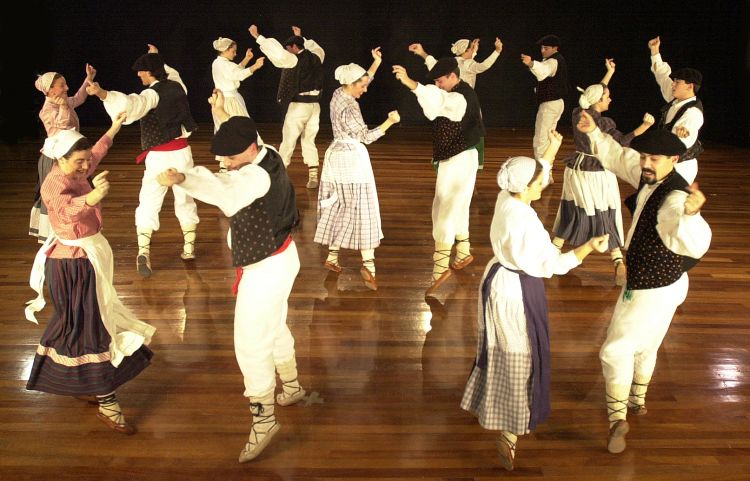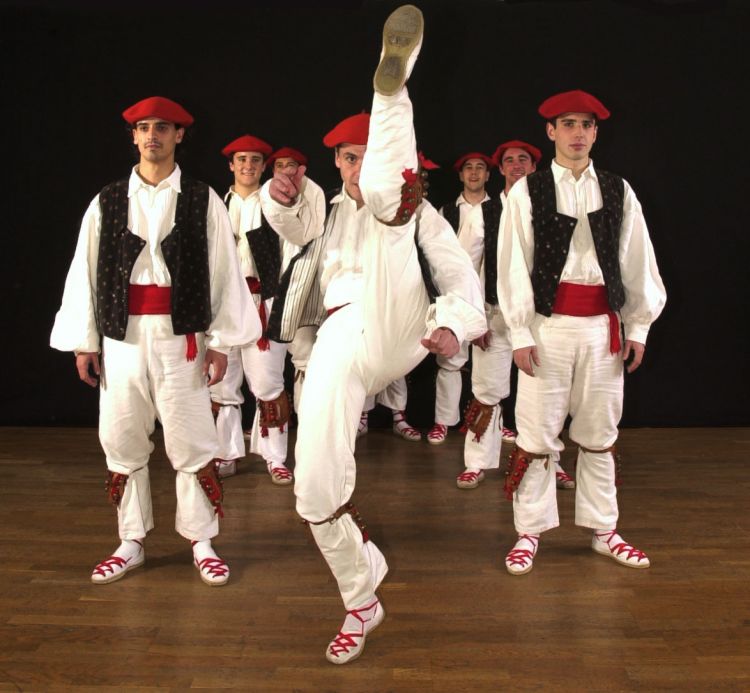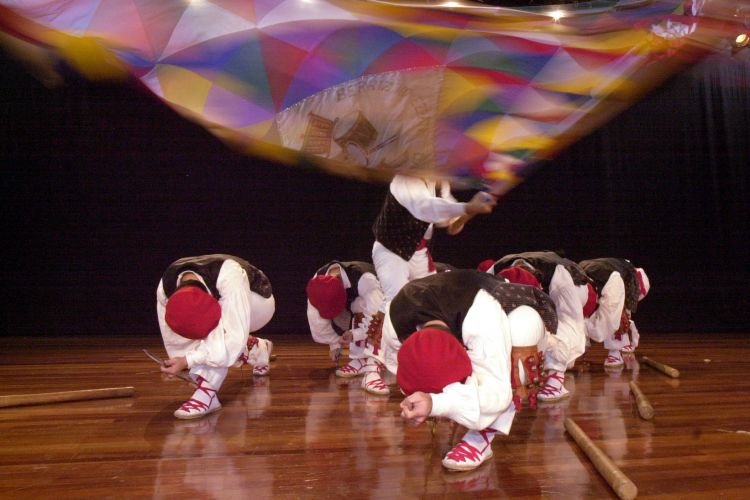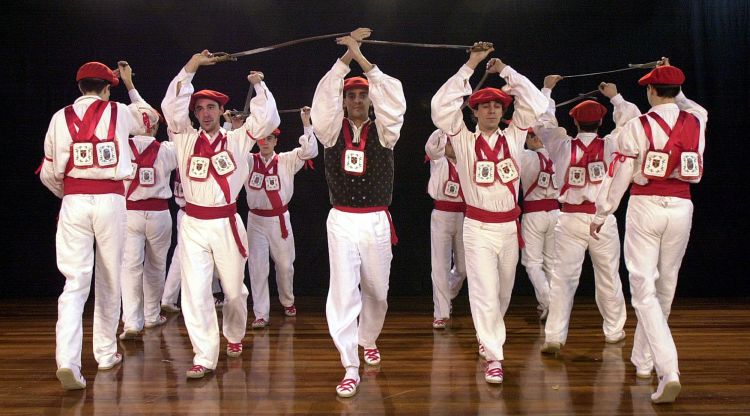Kaixarranka
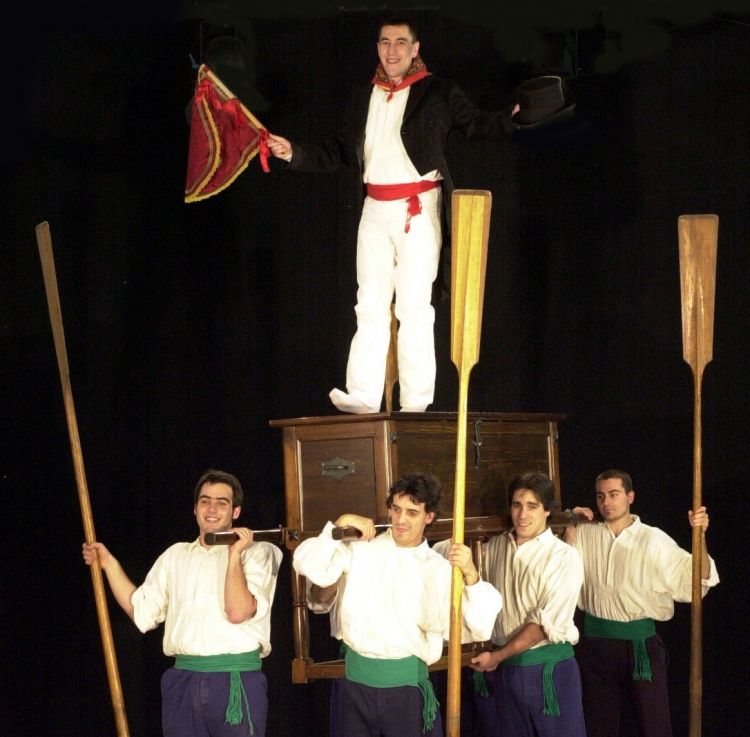
The Kaixarranka is a dance which is currently performed in the town of Lekeitio, at the north eastern end of the province of Bizkaia, a few kilometres from the border with Gipuzkoa.
Data collected from historical archives by various researchers indicate that this is a dance which was originally associated with changes of chief steward in the Seamen's Guild ("Cofradía de Mareantes"). Seafarers who belonged to the guild would gather and choose a group of dancers for the feast of St. Peter, and at the same time elect new guild officers. There would then be a procession with masked men representing St. Andrew, St. John and St. Peter, which would parade through the streets of the town to the homes of the oldest and newest stewards. They would then go to the harbour waterfront and symbolically threaten to cast the saint into the sea if he did not foresee good catches for the year ahead. The use of relics and religious garments in these processions was probably behind the opposition to them among church authorities in the 17th and 18th centuries, which contrasted with the support given by the civil authorities of the time.
The procession then moved on to the Kaixarranka square, with a single dancer on top of a chest which originally contained the papers and accounts of the guild, carried by eight guild members bearing oars as a sign of their status as seamen. Salutes were performed facing the four points of the compass, and a dance was performed by the man balanced on top of the chest. an exhibition of skill in taps, jumps, gurpiles and spins was followed by the fandango and arin arin, which traditionally closed dance cycles in Bizkaia.
Clothing
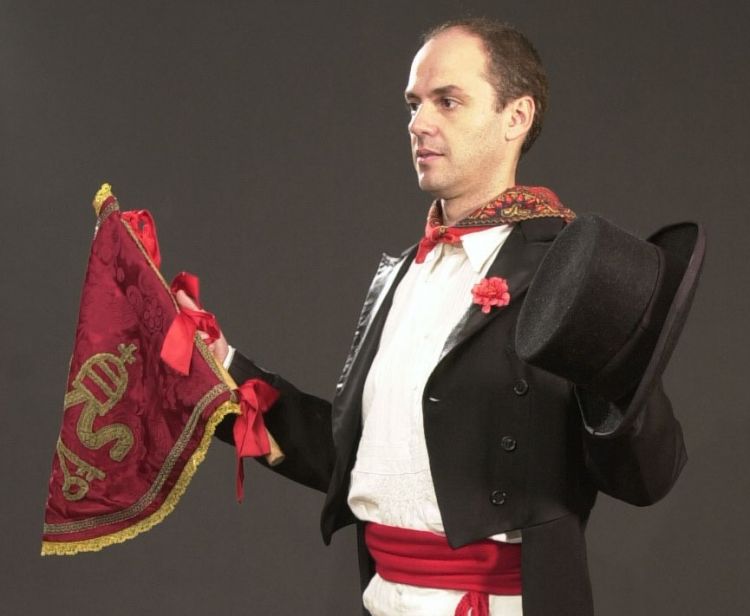
A distinction must be drawn between the time when the Kaixarranka was performed as part of a procession in which the main participants covered their faces with sheets and masks to represent the apostles, and the later period when, as a result of various prohibitions by the church, the masked dancers began to wear laymen's clothing, comprising a 19th century style frock coat and top hat, though they continued to carry a small flag bearing the crown and keys of St. Peter on one side and the coat of arms of the town on the other, as a reminder of their earlier historical role.
The main character is accompanied by eight youths who carry between them the chest of the guild, and are dressed in fishermen's clothing, i.e. dark blue shirts and trousers. Around their waists they have been known to wear green sashes rather than the red ones found in other parts of the province. They may wear dark rope-soled sandals or may go barefoot after the fashion of seafarers accustomed to walking among ropes, masts and sails.
For some time now the performance has been completed by a group of women playing the part of net-menders, dressed in traditional costume (white petticoats protruding below checked skirts or dressed, and bare feet), who take part in the fandango and the arin arin.
Implements
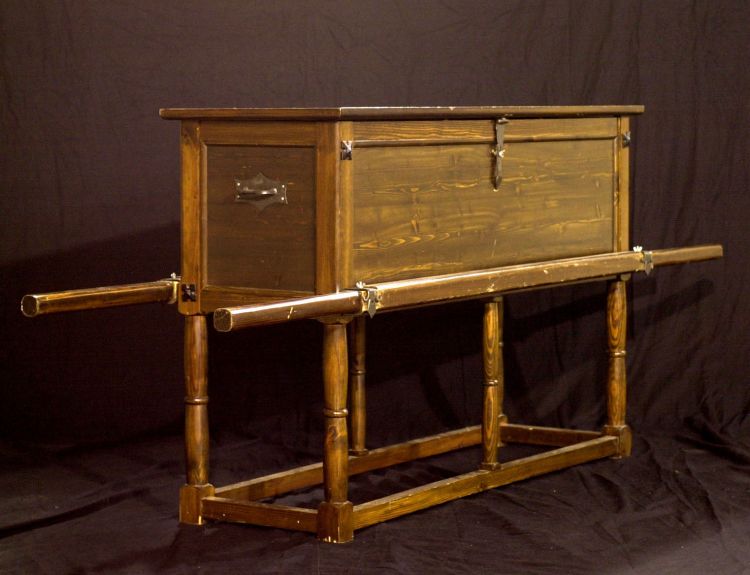
The following are used typically in the Kaixarranka dance in Lekeitio: first of all the masks and costumes representing the apostles which were used in the procession of the Seafarers' Guild. Secondly, the oars borne by guild members to represent the work of the faithful. Thirdly, the Kutxa or Kaixa (chest), in which the documents and accounts of the guild were traditionally kept, and which was passed on from steward to steward over the years. Finally, in modern-day performances, the nets and fishing tackle carried by the women who take part in the dance.
Music
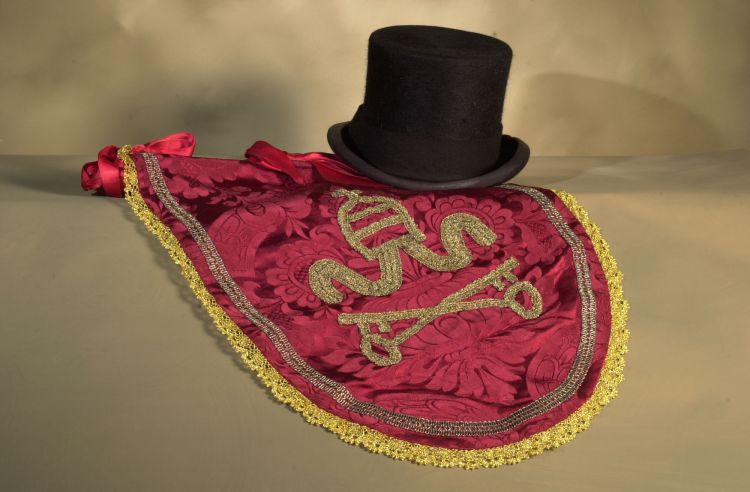
The dances involved in the Kaixarranka were traditionally performed to the tune of the txistu flute and the tamboril drum.
History and Geography
Maria Elena de ARIZMENDI AMIEL (1) says that exhibitions and processions by the religious authorities and the officers of the guild were staged at prior to 1600 to mark the feasts of St. Peter and St. John. After the high mass, the participants paraded to the crossroads of Amia, where they chose the members who would be masked to represent St. Peter, St. John and St. Andrew in the procession. There are many references in the 17th century which confirm that this was a deep-rooted tradition, though in the 16th and 17th centuries there was some discussion between the religious authorities and the Council of Mayors as to whether it was proper. The following text, taken from the aforesaid work, dates from 1607.
"Proceedings: In the town of Lequeitio on this 30th day of the month of June in the year 1607; Heard by myself, Alonso Lopez Cordido, notary of His Majesty and his Rector of the Royal Courts and the Chancellery of Valladolid, and Executive Judge appointed by O. Antonio de Amezqueta, Chief Justice of Vizcaya, to execute the Royal writ of sentence handed down at the request of the Guild of Seafarers of St. Peter of the said town against Master Láriz, Vicar of the Church there and mayor thereof; The said writ of sentence, the handing down and fulfilment of which has been entrusted to myself, evidence having been gathered and investigations made in relation thereto, and notice given to Master Láriz, vicar of the town and of its church, with whom this proceedings was carried out, and to Martin de Asterrica and Juan Bta. de Renteria, the Mayor: I find and declare that the said members of the seafarers' guild of the town of Lequeitio be given the protection of law, as they were certainly protected in their possession of old, in regard to their custom on the eve of the feast of Saint Peter, to wit the twenty-eighth day of June, at two hours after noon, in that some of their number do gather along with the stewards of their guild to appoint the dancers and persons who are to represent the apostles, and to appoint those who are to dance upon the festivities of said feast, which last from the said eve until the day of the Visitation of Our Lady, ending on the second day of July each year; and that moreover those who are now stewards and occupy that post henceforth should appoint, as they did of old, three persons from among the members of the guild of seafarers to represent the apostles Saint Peter, Saint Andrew and Saint John after the fashion in which this has been done until now, viz. with masks, crowns and sceptres, with the three masks having each its cloak; and that on the day of the feast of Saint Peter the said guildsmen should hear mass and the sermon as is their custom, viz. with the three persons masked and bearing their crowns and sceptres.
Thereafter on the second day, being Saturday and the thirtieth day of the month between two and three of the afternoon the regiment of the town shall gather, bearing as they come the flag of said town, to the house of the former chief steward of the guild who has in his charge the chest called the Chest of Saint Peter; and that they shall, with the veneration and solemnity which has ever characterised such acts, process through the chief streets of the town. On the Chest of Saint Peter shall stand the guildsman who represents Saint Peter, with his mask, his crown and his sceptre in hand, and those representing Saint John and Saint Andrew go on either side of the said chest, garbed in their masks, crowns and sceptres; and that the said procession shall in the manner indicated return the chest to the home of the steward that enters at that time into that office; then let the oldest among them take to his house the chest and let the three guildsmen who represent the said three apostles be garbed in their masks and other insignia aforesaid from the day of the feast of Saint Peter to that of the Visitation of Our Lady. But the dancers who shall perform the dances and those persons who represent the apostles shall be under no obligation to perform their dance anywhere, nor in any private home, other than in those places where their own authority and free will make take them.
I further order Master Láriz the vicar and the mayors at this time and hereafter of the town of Lequeitio, and the vicar and priest of the church thereof that they guard and fulfil the contents of this writ and do not breach same or consent to the breach of same, nor take any step against same under the penalties indicated in the writ of sentence along with a further five hundred marks for the King's prosecutor, and under penalty of action against them as remiss and disobedient. His Majesty in his writ of sentence establishes these penalties: that the said Master Láriz and other priests of the church of the said town of Lequeitio be stripped of their worldly goods and considered as strangers in this kingdom. This I pronounce and order, in the presence of the witnesses after noon the dancers and with them the said stewards new and old went together with the constables and the offers of the regiment of this town and the most honourable men thereof and men from elsewhere, with their dances and drums and the flag of the town, all of them together, save only that the said gathering included no priest or person of the religious authorities, for they said that they had an edict from their judge that all the priests should not go as has been said. They went to the doors of the home of Pedro de Lecoya, the former steward, and when the chest was in the street the young men took it up and a man climbed up thereupon with a pontifical latria upon his head and a mask resembling the visage of an old man upon his face, and upon his back a mantle like that of a clerics, bearing a golden key in his hand, accompanied by two other men, one on each side of the chest, who represented Saint Andrew and Saint John, with their masks and mantles after the fashion of clerics. The said chest was borne aloft amid drums and dancers and mask wearers and other men dressed in disguise running through the streets, with horses and some harquebusiers drawing it on, in company with all the aforesaid ........ [they went to] the harbour-front where the sea beats, with much joy .... all those in the said company being laymen save two Dominican friars from the Convent of Saint Dominic of the town, there being among them no priest of the church chapter, save that any may have gone there in disguise."
In 1611 the church chapter failed to prohibit attendance at these events. Disputes arose between the church and civil authorities concerning whether ministers of the church should participate in civil festivities which had a clear, if deeply buried, pagan origin. The church defended its rights and the civil authorities defended theirs, and the dispute continued right up to the present day. Changes have been made in the festivities at the request of both sides. Fir instance instead of the three apostles only ghosts are now represented. The dancer dressed in classical Greek style representing St. Peter has given way to a man dressed in a frock coat bearing a pennant with symbols of the Vatican which still recall former times, and a top hat as a symbol of his authority.
Ezpata Dantzak:
Julio de URQUIJO (2) has this to say:
"The Stewards spend a great deal on the feast of St. Peter and the days that follow it, but the money is well spent in feasting such a great patron. They formed sword dances with drums and a chest, and the festivities began on the eve of the Saint's day and continue until July 2nd. Every day around nightfall the famous old dance known as ´Vizcarracerretia" was performed. This involved various somersaults, "fighting" with dancers one on top of another raised on arms and shoulders, and was completed with the dancers hopping on one foot, with their other foot touching the next dancer. The leader carried a burning brand in his mouth with which he burned their beards. For their persistence and their ability to remain on one foot while holding on to the other the people looked on with much laughter and pleasure [...] Then the Guild passed performing the sword dance, going with their drums to the Casilla de la Atalaya, where they chose new stewards. In the evening from time immemorial up to sixteen ninety they started out from the home of the oldest steward, where the chest called the Chest of St. Peter was kept, and performed the said sword dance [...]".
The data are conclusive as regards the performance of sword dances in the town, through no indication is given of the type of performance involved. On grounds of proximity we may assume, however, that they were of the type called "danzas de pabellón".
(1) ARIZMENDI, Mª E., Vascos y Trajes, Caja de Ahorros Municipal de San Sebastián, Donostia, 1976. It is possible that the quote may have been taken from the article by Juan de IRIGOYEN entitled El Baile Llamado de la Caxarranca, published in the magazine Dantzariak, issue nº 2, in August 1971. The wording of the quote is the same.
(2) URQUIJO, J., Kaxarranka. Dantzariak magazine issue nº 1, August 1970, repeating the article published in Revista Internacional de Estudios Vascos (RIEV), t. XXII, 1931.

